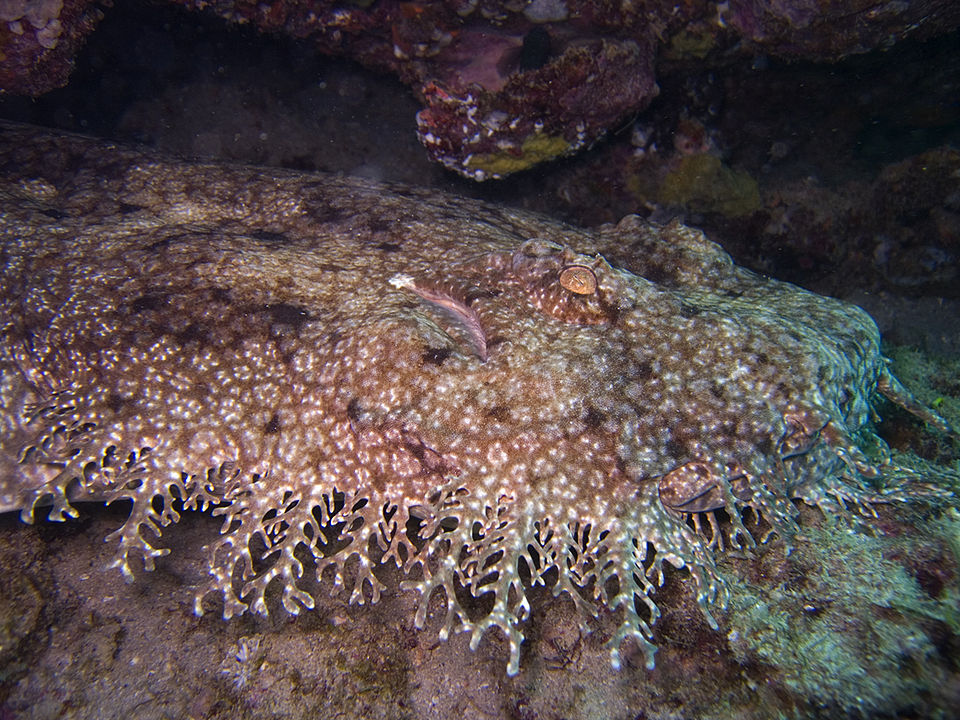
The Seafloor Has a Carpet – A Shark You Shouldn’t Step On
No, it’s not part of the coral reef. Image credit: Jon Hanson
The tasselled wobbegong is considered the most specialized member of its family. Its ornate coloration and complex outlook grants it excellent camouflage, while it is probably a slower swimmer than related species. But that by no way means a disadvantage for this guy.
While these animals are solitary and individual sharks have a small home range, containing several preferred resting spots that are used repeatedly, this species becomes more active at night, swimming onto the reef to hunt. Its enormous mouth allows even sizeable prey to be swallowed, with one documented case of a 1.3 m (4.3 ft) long individual consuming a 1.0 m (3.3 ft) long brownbanded bamboo shark. Although the carpet shark is most active at night, it is an opportunistic ambush predator during daytime, preying upon schooling nocturnal fish such as soldierfish and squirrelfish, and sweepers that often shelter in the same cave. Also, tiny fish and crustaceans have been seen settling atop the resting wobbegong’s head, attracting larger fish that are in turn attacked by the wobbegong. Wow.
In fact, observations of these animals in captivity have further revealed that this species seems to engage in an active luring behavior. And a really special one, for that matter. When the tasselled wobbegong perceives food nearby, it begins to slowly wave its tail back and forth, which makes its caudal fin resemble a small fish, complete with a dark eyespot at the base. And since the shark typically rests with its head elevated, it is situated within easy distance of any prey drawn by that curious tail. Even humans.
Yupp, wobbegongs have several records of attacks on people that were apparently unprovoked, and the tasselled wobbegong has a reputation for even more aggressive behavior than related species. Australian biologist Gilbert Whitley even wrote in 1940 that it “attacks and generally kills the natives” of Papua New Guinea. And while it’s unclear whether Whitley’s claim held any truth, this species is certainly capable of inflicting severe wounds on humans. That said, the tasselled wobbegong is also an ecotourism attraction and many divers have approached it without incident. But given this shark’s cryptic appearance and poor vision, humans should definitely exercise caution to avoid accidentally harassing it or causing it to mistake a hand or foot for prey.
The tasselled wobbegong is considered the most specialized member of its family. Its ornate coloration and complex outlook grants it excellent camouflage, while it is probably a slower swimmer than related species. But that by no way means a disadvantage for this guy.
While these animals are solitary and individual sharks have a small home range, containing several preferred resting spots that are used repeatedly, this species becomes more active at night, swimming onto the reef to hunt. Its enormous mouth allows even sizeable prey to be swallowed, with one documented case of a 1.3 m (4.3 ft) long individual consuming a 1.0 m (3.3 ft) long brownbanded bamboo shark. Although the carpet shark is most active at night, it is an opportunistic ambush predator during daytime, preying upon schooling nocturnal fish such as soldierfish and squirrelfish, and sweepers that often shelter in the same cave. Also, tiny fish and crustaceans have been seen settling atop the resting wobbegong’s head, attracting larger fish that are in turn attacked by the wobbegong. Wow.
In fact, observations of these animals in captivity have further revealed that this species seems to engage in an active luring behavior. And a really special one, for that matter. When the tasselled wobbegong perceives food nearby, it begins to slowly wave its tail back and forth, which makes its caudal fin resemble a small fish, complete with a dark eyespot at the base. And since the shark typically rests with its head elevated, it is situated within easy distance of any prey drawn by that curious tail. Even humans.
Yupp, wobbegongs have several records of attacks on people that were apparently unprovoked, and the tasselled wobbegong has a reputation for even more aggressive behavior than related species. Australian biologist Gilbert Whitley even wrote in 1940 that it “attacks and generally kills the natives” of Papua New Guinea. And while it’s unclear whether Whitley’s claim held any truth, this species is certainly capable of inflicting severe wounds on humans. That said, the tasselled wobbegong is also an ecotourism attraction and many divers have approached it without incident. But given this shark’s cryptic appearance and poor vision, humans should definitely exercise caution to avoid accidentally harassing it or causing it to mistake a hand or foot for prey.
Advertisements
24 August 2023
Advertisements



